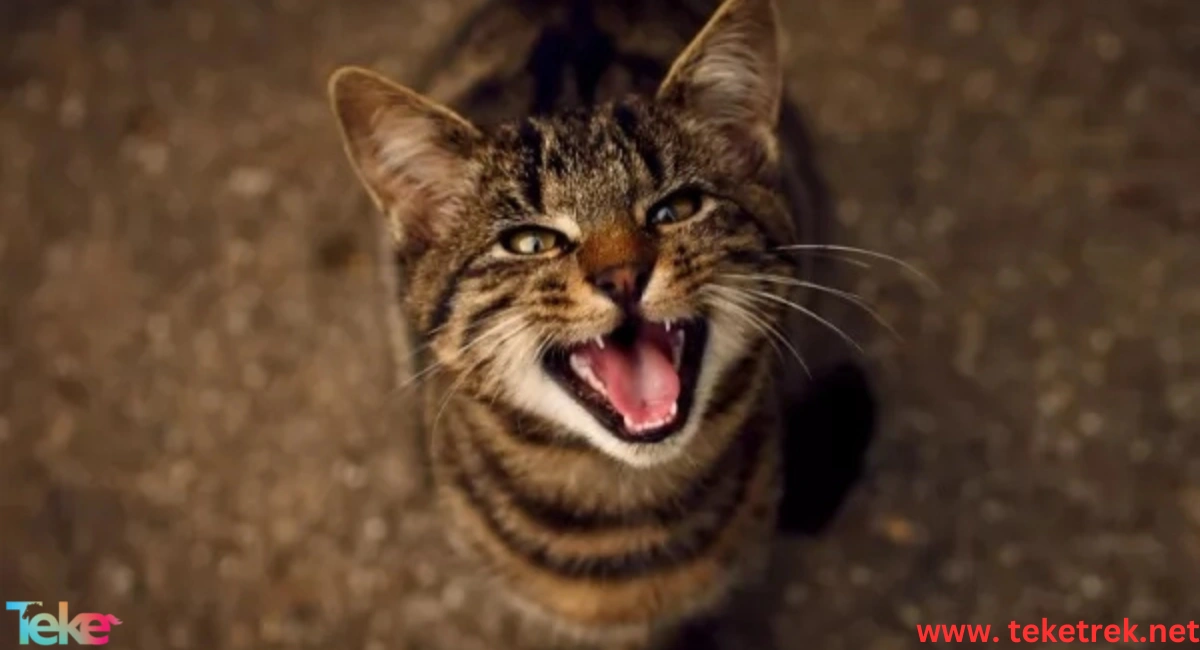In truth, meowing is not just an annoying sound—it’s a powerful and emotional form of communication. Cats are, by nature, sensitive creatures who express their needs and emotions through this repeated sound, which can be a significant indicator of their mental or physical state.
When the meowing becomes constant or unusual, it’s important to pause and investigate the underlying reasons, which may range from hunger or pain to simply seeking attention. Annoying cat meowing is a symptom, not a condition in itself, and should be handled with sensitivity and intelligence.
In this article from teketrek, we’ll explore every possible reason for this behavior and present ways to treat excessive cat meowing by understanding their behavior—especially at night, after adoption, or in times of anxiety. We’ll also discuss the vocal language of cats and how to interpret and respond to it.
Cat Meowing Due to Hunger
Hunger is one of the most common reasons cats meow persistently. This meow is usually sharp and noticeable, often accompanied by behaviors like circling the food bowl or staring directly at the owner. These signs might indicate an issue with the feeding routine or meal timing, such as:
- Cats meow to remind us of their mealtime—they’ve associated us with food.
- The food amount might be insufficient, or the type not filling enough, especially if the cat only eats dry food without a balance of wet food.
- Repeated meowing at mealtime isn’t always true hunger—it can become a learned behavior.
By organizing meal times and using appropriate cat food types, this vocal behavior linked to hunger can be reduced. Since cats thrive on routine, simply adjusting their diet plan can often decrease the annoying meowing.

Cat Meowing Due to Pain or Illness
Not all meowing means hunger or a need for attention. Often, it signals a hidden health issue. Cats naturally tend to hide pain, so meowing might be their only way to let us know something is wrong:
- Meowing accompanied by lethargy or a change in activity may point to chronic illnesses or infections.
- Conditions like urinary tract infections or thyroid problems can cause a noticeable increase in meowing.
- A sudden change in the cat’s voice or behavior may require immediate medical attention.
If your cat’s vocal tone expresses pain or discomfort, do not ignore it. Visiting the vet is essential to diagnose the issue before it worsens. Don’t wait until the meowing turns into screaming.
Cat Meowing at Night: Causes and Solutions
One of the most common complaints among cat owners is nighttime meowing, which can disrupt the whole household’s sleep. But this behavior isn’t usually aggressive—it’s more a sign of a specific need. It may indicate:
- Cats are naturally nocturnal, so their activity peaks in the evening.
- The cause may be boredom, hunger, loneliness, or anxiety.
- Sometimes, nighttime meowing results from aging or feline dementia.
You can soothe annoying nighttime meowing by creating a sleep routine, offering a light meal before bed, and encouraging daytime activity. A restful night for your cat means peaceful sleep for you, too.
Cats Use Their Voice to Seek Attention
Not all meowing is due to pain or hunger; some of it is simply a way to get your attention. Cats quickly learn that sound attracts humans, so they start using it for social interaction:
- Your cat might meow to request playtime, cuddles, or just to sit beside you.
- Frequent meowing when you’re busy may mean she feels ignored or lonely.
- Some cats develop the habit of meowing for no clear reason, just because they know you’ll respond.
Balanced, positive interaction helps your cat feel secure without relying on meowing as a constant tool. Be present, but don’t feel pressured to always respond—otherwise, the meow could become a means of control.
Cat Meowing After Adoption: The Adjustment Period
Cats moved from one environment to another go through a phase of stress and anxiety called the adjustment period. During this time, excessive meowing becomes more evident as a way to express discomfort:
- This meowing stems from unfamiliarity and fear of the new surroundings.
- It may be accompanied by behaviors like hiding, pacing, or crying near the door.
- This meowing doesn’t necessarily signal a problem—it’s natural in the early days post-adoption.
Give your cat time, space, and affection to adapt. Provide a warm spot, avoid loud noises, and respond gently to her calls. Safe interaction is the first step to healing.
A Comprehensive Guide to the Bubblefish: Specifications, Food, Breeding, and Home Care
When Is Meowing a Medical Concern?
Not all meowing is simple or innocent. Sometimes, it signals a serious medical issue that requires immediate attention. Knowing when to stop guessing and start seeking medical care is crucial:
- Red flags include: persistent meowing, voice change, appetite loss, vomiting, or lethargy.
- Sudden, unexplained meowing that doesn’t subside within days likely points to illness rather than behavior.
- Ignoring these signs may lead to severe complications.
Timely veterinary consultation is the first step in protecting your cat’s health. Don’t wait until the meow becomes a cry for help.

Tips to Reduce Constant Cat Meowing
If your cat is meowing all the time, there are a few proven tips to help calm this behavior. The journey always starts with understanding, then organization. Some useful tips include:
- Set fixed meal times and use filling, nutritious cat food.
- Ignore unnecessary meowing to prevent it from becoming a learned habit.
- Dedicate daily playtime and interaction with your cat.
- Keep the litter box clean and the home environment calm.
- Consult a vet if meowing continues despite all efforts.
By understanding your cat and providing a stable, loving environment, you can naturally reduce excessive meowing—without yelling or punishment.
Conclusion
Cat meowing isn’t just daily noise—it’s an open window into their inner world. Behind every meow lies a feeling—hunger, pain, anxiety, or even a desire for affection.
Annoying cat meowing becomes such only when we refuse to understand it. But by deeply understanding their vocal language, we can interpret their signals wisely. They don’t cry out for no reason—they whisper to us what they cannot say in words.
Sometimes the meow reflects odd cat behaviors expressing discomfort or boredom. Other times, it’s an early warning sign of a hidden health issue. Ignoring it can cost the cat much pain—and us, a lot of regret.
While the causes of nighttime meowing may repeat, it’s our responsibility to create a safe and calm environment with a proper diet that balances dry and wet food to ease anxiety and ensure physical and emotional satisfaction.
In adoption periods, meowing is the voice of fear of the unknown, needing our patience and comfort—not scolding or neglect.
In the end, treating excessive cat meowing doesn’t start with silence—it starts with understanding. It’s not about how often we stop the meow, but how often we truly listen.
Your cat doesn’t need many words—just love, care, and presence.





